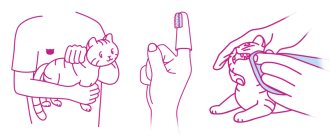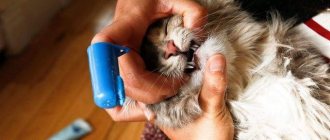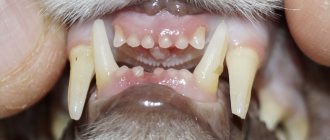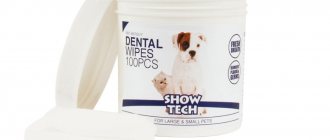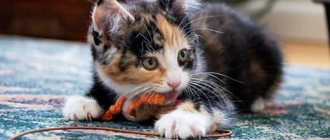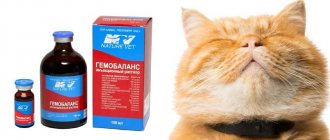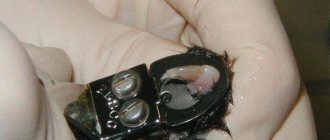In apartment cats, tartar often forms - a calcareous deposit on the base of the tooth, almost at the very gum. First, a soft coating appears, then, if it is not removed, it thickens and becomes stone-like. The animal cannot get rid of it on its own, especially if it receives soft food.
The process of mineralization (stone formation) itself is painless and does not bring any unpleasant sensations to the cat, but if measures are not taken in time, big problems can arise, including sepsis. Pet owners regularly ask specialists questions about how tartar is removed from cats and how to prevent its occurrence.
What is tartar
The growth of stones is provoked by ossified remains of food, saliva, putrefactive bacteria, and minerals contained in water. All this enters into a violent chemical reaction with each other. Depending on the location of the formation, there are:
- supragingival;
- subgingival.
The first can be seen in the area of the canines, incisors and premolars. The plaque has a light yellow tint, which gradually darkens and turns brown. The subgingival is located on the very neck of the tooth, in a pocket under the tissues. It is impossible to recognize subgingival tartar in the photo.
What does tartar look like?
The tartar on cats' teeth is a colony of microorganisms. Essentially, it is a ossified plaque on the outside of the teeth.
It includes traces of food, bacteria, dead cells, as well as calcium, phosphorus, and iron salts. What does he look like? Visually, this is plaque or crusts at the base of the animal’s teeth. The color can vary from yellowish to dark brown. It is important to remember that a cat’s tartar is located not only on the visible part of the tooth, but also under the gum. Therefore, diagnosis is often difficult.
Why is it dangerous?
Veterinarians warn that if tartar is not treated in time, the animal may not only lose a tooth, but also die.
The main danger is that the stone on the cat’s teeth grows, forming a pocket in the animal’s gum. Gingivitis, caries, periodontitis, periodontitis, osteomyelitis, fragility of teeth, pulpitis, stomatitis - an incomplete list of diseases resulting from the spread of tartar.
The consequences of these diseases: inflammation, abscesses and fistulas of the gums, the formation of ulcers, swelling, loosening of teeth and their loss, enlarged lymph nodes. As a result of swelling and ulcers on the mucous membrane of the mouth, the cat cannot eat and swallow food normally, which leads to diseases of the stomach and intestines. In addition, inflammation can spread from the mouth to the ear, causing otitis media.
The greatest danger lies in purulent processes that can affect the brain or spread through the bloodstream. In such cases, the animal dies.
Terms of education
The first signs of tartar can be noticed in young cats that are not even a year old, especially if we are talking about purebred representatives. It is known that among elite cats, tartar is more common. On average, the age when pathology becomes obvious is 4-5 years.
Factors influencing the rate of tartar formation in cats:
- poorly prepared diet, especially food from the common table;
- improper bite aggravates problems, making natural self-cleaning impossible;
- nutrient metabolism disorder;
- lack of access to quality drinking water;
- lack of oral hygiene.
Perhaps the first and last points are the most important in this matter. Without regular brushing of teeth, and even with poor nutrition, the cat runs the risk of acquiring stones at a fairly young age.
At-risk groups
Some breeds of domestic cats have a genetic tendency to develop plaque. These include Siamese, British, Scottish fold and Persian individuals.
Also at risk are animals that eat exclusively soft homemade food and do not receive oral care.
How to care for trainers
Caring for jaw trainers is very simple and does not require special skills. It is available to patients of all ages. Follow simple rules:
- Always rinse the device after removing it from your mouth. Whenever it gets dirty, clean the trainer with a toothbrush and toothpaste, just as you would brush your teeth.
- Store the product in a special container to prevent dust, dirt and accidental damage.
- Do not chew, chew, or boil the apparatus. You need to rinse it with warm water, not cold or hot, otherwise you can ruin the plastic.
- If the trainer is damaged, you should immediately take it to the orthodontist so that the doctor can tell you whether you can continue to use the product or whether you need to buy a new one.
Reasons for fossils
Dental problems can be caused by the following factors:
- lack of timely hygienic treatment of the oral cavity;
- trauma, extensive deep caries, gum damage;
- the absence of a neighboring tooth on the opposite jaw, which provides friction when chewing food;
- malocclusion or curvature of the jaw bones;
- metabolic disorders in the animal's body;
- incorrectly selected diet;
- drinking tap water.
If your cat is at risk, do not neglect preventive visits to your veterinarian.
Plates for teeth straightening
Orthodontic plates are often called “braces” or “plates on the teeth.” This device is used to treat children under 15 years of age. Made individually for each child. It is attached to the outer surface, the inner part and can partially cover the sky. Made from soft or medium hard plastic and metal. The child takes food without any discomfort. There is no need for any special care for the plates.
Purpose:
- abnormal development of the bones of the jaw arches (narrowness of the jaw bone or disruption of its shape);
- the need to adjust the position of one or more teeth;
- movement of individual teeth;
- the presence of gaps between teeth (three and diastemas);
- the need to correct the narrowing of the palate;
- activation or slowdown of the jaw growth process;
- consolidation of results after using other orthodontic systems;
- preventing crowding;
- prevention of relapses of malocclusion, etc.
There is no need for any special care of the plates
Early and late stage symptoms
You can determine whether your pet suffers from tartar plaque on their teeth by a number of symptoms:
- a strong putrid odor emanates from the animal’s mouth even at the initial stage;
- on the base of the tooth, near the gum itself, a dark plaque is visible to the naked eye, the shade of which can reach brown in advanced cases;
- the gums are red and inflamed and begin to bleed at the slightest contact with food;
- hypersalivation is noted - excessive secretion of saliva, it occurs at any stage of the disease;
- unstable position of teeth, sometimes – their loss;
- swelling of the animal's oral mucosa;
- behavior that is unusual for an animal while eating - restlessness, attempts to move away from the bowl and immediately return to it, dissatisfied growling, strong slurping;
- complete refusal of solid food;
- scratching cheeks on corners of furniture.
It is worth remembering that some symptoms individually may be manifestations of another disease. For example, bad breath often characterizes a malfunction of the gastrointestinal tract or the development of cancer (in this case, the smell has a putrid-sweet character). Rubbing the muzzle against a surface may indicate an allergic reaction or the presence of ear mites.
Diagnosis of pathology
If you notice alarming symptoms in your furry friend, you should be wary. These phenomena in a cat can be symptoms of both tartar and other dental diseases.
To make sure that the problem is indeed fossilized plaque, you can perform the following test. To do this, just moisten a cotton swab with Lugol's solution or iodine (5%) and rub your teeth with it, grabbing the gums adjacent to them. After performing this manipulation, the stone is clearly visible.
The plaque on the enamel may be removed after such a procedure, but the supragingival stones will remain and acquire a dark brown color. However, this method is suitable for identifying only supragingival stone. The subgingival calculus will be detected by the dentist during an examination.
It is best to entrust the diagnosis of the presence of tartar in a cat to a veterinary dentist. This is a narrow specialist with extensive experience. The examination is carried out using a special dental mirror: the mucous membrane of the cheeks and tongue is carefully checked for the presence of ulcers and lesions, and the condition of the teeth and gums is assessed.
Kinds
A veterinarian should prescribe pain medication for your cat. Only a specialist can assess the need for analgesic therapy and select the type, brand and dosage of the medication. When prescribing, the biometric characteristics of the pet (weight, age, gender), its health and physiological condition must be taken into account.
In cat veterinary medicine, a limited list of drugs is used.
Most analgesics used to treat humans, dogs, and large pets are toxic to cats.
Types of drugs used in cats:
- Opioids. Narcotic drugs.
- Non-steroidal anti-inflammatory drugs.
- Local anesthetics.
- Alpha2-adrenergic agonists (alpha2-adrenergic receptor agonists).
- NMDA receptor antagonists.
- Anticonvulsants.
Opioids
The most effective painkillers prescribed for moderate to severe pain. They block pain, acting at the level of the central nervous system, and have a sedative and calming effect. The main active ingredient of drugs of the narcotic class is morphine. They are used mainly in the form of injections, inhalation anesthesia and epidurally as prescribed by a doctor in a clinical setting.
Indications for use: surgery, severe injuries and cancer.
Advantages: universal, safe, reversible, inexpensive.
Disadvantages: can cause hyperthermia, bradycardia, difficulty breathing and agitation in the cat, and have a high sedative effect.
Preparations:
- Morphine;
- Fentanyl;
- Buprenorphine;
- Nalbuphine;
- Hydromorphone;
- Tramadol;
- Butorphanol;
- Codeine;
- Omnopon.
Dosage: selected individually by your doctor.
Nonsteroidal anti-inflammatory drugs
A group of available drugs with combined action. NSAIDs treat the source of pain (inflammation) and have an analgesic effect. The analgesic effect of NSAIDs is lower than that of opioid drugs. Prescribed for moderate pain syndrome and long-term treatment of diseases of the musculoskeletal system.
Indications for use: teeth cleaning, castration, treatment of simple abscesses, osteoarthritis, arthrosis, ligament rupture, sprains, intervertebral hernia, neoplasia and joint dysplasia.
Advantages: long-lasting effect, non-addictive, easy to administer.
Disadvantages: not suitable for cats with severe systemic diseases, renal and liver failure, bleeding disorders, gastrointestinal ulcers.
Preparations:
- Meloxicam (Metacam®);
- Ketofen;
- Ketonal;
- Quadrisol;
- Rimadyl;
- Flexoprofen;
- Norocarp;
- Vetalgin.
Release forms: tablets, ointments, gels, injection solutions.
Dosage: as prescribed by a veterinarian.
Local anesthetics
Effective drugs with a slow onset effect and a long duration of action. Used for local anesthesia. They do not cause addiction or side effects.
Indications for use: surgical treatment of injuries, sterilization and castration operations.
Advantages: effective, inexpensive, without addictive effects.
Disadvantages: if the dosage is observed, there are none.
Preparations:
- Lidocaine;
- Bupivacaine.
Dosage: 1-1.5 mg/kg bupivacaine; 2-5 mg/kg lidocaine.
Alpha2-adrenergic agonists
A group of drugs with sedative and analgesic properties. Provide light and deep sedation. Used for simple surgical procedures and clinical research.
Indications for use: pre-anesthesia preparation, recovery period after surgery.
Advantages: reversible, provide sedation.
Disadvantages: contraindicated in animals with cardiovascular diseases.
Preparations:
- Medin;
- Dexdomitor.
Release form: solution for injection.
Dosage: prescribed individually.
NMDA receptor antagonists
Used for cat anesthesia and pain relief. Used in preoperative preparation, during surgical operations, and in emergency medicine. Reduces nervous excitement of animals.
Indications for use: sterilization/castration operations, caesarean section, neuropathic pain.
Advantages: inexpensive, used for anesthesia.
Disadvantages: contraindicated in animals with epilepsy, hypertrophic cardiomyopathy.
Preparations:
- Ketamine.
Release form: solution for injection.
Dosage: prescribed individually.
Anticonvulsants
Prescribed for the treatment of neuropathic pain. They have a pronounced analgesic and anticonvulsant effect.
Indications for use: post-traumatic and postoperative pain, disc pain, epileptic seizures.
Advantages: high efficiency.
Disadvantages: not prescribed to pregnant and lactating cats, animals with liver and kidney diseases.
Preparations:
- Gabapentin.
Release form: tablets and capsules.
Dosage: prescribed individually by a veterinarian.
Methods of treatment at the veterinary clinic
The treatment procedure involves removing mineral residues. At an early stage of the disease, it is possible to help the animal yourself, but if the plaque has hardened, removal must be carried out in a clinic.
Using special tools and a scaler
Tartar cleaning in a veterinary clinic is done in two ways:
- mechanical;
- using ultrasound.
The first method of treatment is currently rarely used. During the procedure, plaque is removed using special dental instruments. The effect is short-term, since only those stones that are visible to the naked eye are removed, and the gum pockets are not affected.
Since tooth enamel is rough and uneven, the problem returns quite quickly. During mechanical cleaning, there is a high risk of traumatizing the enamel, which can lead to the appearance and spread of caries, as well as pain in the animal.
Often, the doctor touches the mucous membrane and gums, creating scratches that become inflamed when bacteria enter them. The manipulation is performed without anesthesia. The advantage is the low price.
Ultrasonic cleaning
Tartar removal using ultrasound is performed only under general anesthesia, which is a significant disadvantage, despite the effectiveness of the procedure. This method allows you to completely clean the tooth surface without causing any discomfort to the animal.
The ultrasonic wave changes the structure of the deposit, making it looser, after which it peels off. The enamel and mucous membranes are not affected. After the procedure, the teeth are polished and fluoridated. The smooth, protected tooth surface prevents food debris and minerals from clinging to it.
In some cases, when there is a high risk of complications from anesthesia, the ultrasound procedure is performed without it using sedatives. It is prohibited to use anesthesia in older animals or with diseases of the cardiovascular and genitourinary systems.
How to put on and wear a trainer correctly. How long does it take to get used to
Adult and children's dental trainers are put on and worn the same way. Installing the device is quite simple:
- Place the device in your mouth so that the central stop is directed towards the upper palate. Next, find a position so that the stopper rests on the tip of the tongue and does not create discomfort.
- Move your lower jaw in different directions until the plates fit on the molars. Have you stopped slipping? You have achieved the desired result.
- Close your jaws with little force. You should feel pressure on all your teeth. You can touch the tip of the trainer with your tongue to feel if it fits correctly.
- Check if the trainer is positioned correctly: tighten your lips and take 3-4 deep breaths. If breathing is difficult, repeat the previous steps until it becomes easier.
Scheme for putting on the trainer
You need to wear the trainer for 1-4 hours during the day, as well as throughout the night. The regimen is determined by the doctor and must be followed. You can hold it for 30-40 minutes, but you cannot use the device less than necessary. If you need to remove the trainer, try to return it to its place as quickly as possible.
While wearing it, a person should not talk, eat or drink. If you are going to wear a trainer with your child, it is better to come up with entertainment for him during classes, for example, you can watch a cartoon or a movie, or draw. The habit of wearing a trainer develops over different periods of time – it all depends on the patient. At night, it is better to monitor the device regularly for at least a month (it may crash). During the day, the discomfort disappears in about a week, sometimes less.
Do not forget that while wearing a trainer, it is important to see a doctor once every two to three months. A visit to the orthodontist is a necessary procedure, because it allows you to determine the dynamics of changes in the dentition and correct the process in time if something goes wrong.
Removing stones at home
Weak and loose plaque can be removed independently. The most difficult thing in this matter is to cope with the cat, which clearly will not like this procedure.
Special treats and dry food
At the moment, pet supply stores offer a fairly wide range of special treats. The principle of their operation is to soften when exposed to saliva. The consistency of the hard treat becomes like plasticine. It is recommended to treat your pet to such a delicacy at least twice a week.
Veterinary feeds have a special composition and structure of granules. Unfortunately, they cannot remove tartar, but they can remove plaque.
Toys designed to clean a cat's mouth are impregnated with catnip. They have a rough surface that polishes the teeth when the cat bites into the item.
Veterinary wipes
There are many home remedies for removing tartar in cats. One of the most popular is veterinary wipes. Typically, they are soaked in a solution containing baking soda and peppermint.
Wipes have an antimicrobial effect and are also able to soften loose stone (at its initial stage). The principle of operation is very simple - take a napkin, wrap it around your finger and wipe your pet’s teeth.
Of course, it will not be possible to completely remove tartar at home, but this remedy has proven itself to be effective as a preventive measure.
Special means
You can try to remove tartar in cats using special products that soften the plaque and allow you to remove it with a brush or scaler. One of the most popular folk remedies is hydrogen peroxide. It can remove plaque from your teeth, but you must be careful not to touch your gums. Take a cotton swab, moisten it with peroxide and treat the tooth where plaque is visible.
To soften plaque, you can use a variety of gels, pastes and sprays from a veterinary pharmacy. They are applied to cats' teeth using a dispenser. Over time, the stone “moves away” from the tooth enamel.
Not all animals allow you to brush your teeth. In this case, liquids will help - you can add them in the form of drops to a bowl of water. There are also products for oral administration. Tartar under the influence of the product becomes porous, loosens, and can be easily removed from the surface of the teeth - just let the cat chew on a special treat or dry food.
Mechanical cleaning
You can remove plaque at home, but you need to have the skills to work with a scaler. The plaque is pre-softened with a special product from a veterinary pharmacy or hydrogen peroxide. You need to use peroxide as carefully as possible - you need to apply it so that it does not get on your gums. A cotton swab is generously moistened with the solution and applied to damaged teeth.
Next, the scaler is carefully passed from the base of the tooth, that is, from the gums, downwards, scraping off plaque. You need to be very careful not to damage the delicate mucous membranes. In this case, it is better to enlist the help of a relative: one will hold the cat, and the second will carry out the procedure.
After completing the manipulation, it is advisable to treat the pet’s mouth with a weak chamomile decoction. If you have never removed plaque yourself, you can consult a veterinarian about this.
Why trainers are better than other orthodontic devices
Compared to other orthodontic devices, teeth straightening trainers benefit in three ways:
- They do not need to be worn constantly like braces. Therefore, you don’t have to limit yourself in communication or refuse to work with people. At school, children will not suffer from ridicule from classmates;
- they do not put pressure on the teeth. Braces and plates affect the teeth, destroying the enamel and injuring, irritating the mucous membrane;
- they are much cheaper and do not require individual production. The patient can buy a trainer in a store (for example, choose it from the catalog on our website) and immediately start wearing it.
Another plus is that you don’t have to wait for the trainer to be made. All you need to do is ask your doctor which model and size you need, and order it in the store. This is also different from braces, the installation of which takes a lot of time.
